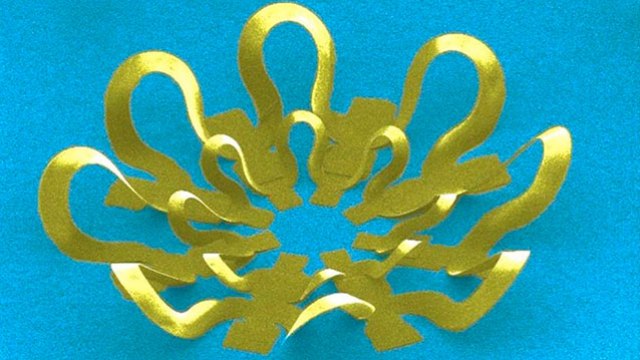 Image Credit: University of Illinois
Image Credit: University of Illinois
Researchers from Northwestern University and the University of Illinois have developed a new fabrication technique which generates complex and attractive 3D nano and microstructures.
The technique imitates the way a children's pop-up book works and provides a number of benefits when compared to traditional 3D printing technology.
The study reported in the Science journal, describes a flat two-dimensional structure which ‘pops up’ into a complex 3D structure. The researchers used advanced materials, such as silicon, in order to create over 40 geometric patterns including the shapes of a starfish, a tent, a basket, a table, a starbust, a flower and a peacock.
In just one shot you get your structure. We first fabricate a two-dimensional structure on a stretched elastic material. Then we release the tension, and up pops a 3-D structure. The 2-D structure must have some place to go, so it pops up.
Yonggang Huang, a co-author from the Northwestern University
The modelling, design and theoretical aspects of the research was led by Yonggang Huang, who is the professor of mechanical engineering and Joseph Cummings Professor of Civil and Environmental Engineering at Northwestern’s McCormick School of Engineering and Applied Science.
The new technique is likely to find practical applications in the fields of electronics, sensors and biomedical devices as it outperforms conventional 3D printing methods in a number of ways. Huang further stated that the team's future work will involve choosing the suitable design for specific applications.
The new pop-up technique is rapid and inexpensive. It uses different materials in order to form a hybrid structure and a large number of structures can be generated at a time using this method. Other key benefits include generating nano and micro-level structures, and creating wide geometrical ranges.
However, integrating more than one material in a structure using 3D printing is complex. 3D printing is a slow process and does not involve printing of single crystalline metals or semiconductors.
"The pop-up technique will expand what is possible. 3D fabrication lets you use the space to gain more function in a structure," said Huang.
We know how to design a 2-D structure so that it pops up into the 3-D structure we desire.
Yihui Zhang a research assistant professor of civil and environmental engineering at Northwestern and a co-author of the study
John A. Rogers, the third co-author of the study from the University of Illinois worked along with the Zhang to develop different 2D structural designs producing various types of 3D structures.
“A key, unique feature of these approaches to 3-D microarchitectures is that they work equally well with a very wide variety of materials, including the highest performance semiconductors, such as device-grade silicon, and fully formed, state-of-the-art planar devices and systems. We believe, as a result, that these ideas have relevance to nearly every class of microsystem technology -- from electronics to photonics, optoelectronics, microelectromechanical structures and others," said Rogers, director of the Seitz Materials Research Laboratory and one of the research team members.
Rogers led the group which carried out the fabrication and experimental work on different structures.
“This is what we call an inverse problem -- you know what you want in the end but you don’t know what structure to begin with. In mechanics, this is what we do, apply theory to determine how to design the initial structure. Fabrication using trial and error is too laborious, but our process is very fast," Huang said.
The key aspect of this technique is the strong and weak adhesion points between the 2D structure and elastomer over which the structure is placed. Upon releasing the stretch, compression buckling occurs such that the strong adhesion points remain on the elastomer plane while the weak points tend to break down. This results in the popping up of the desired 3D structure.